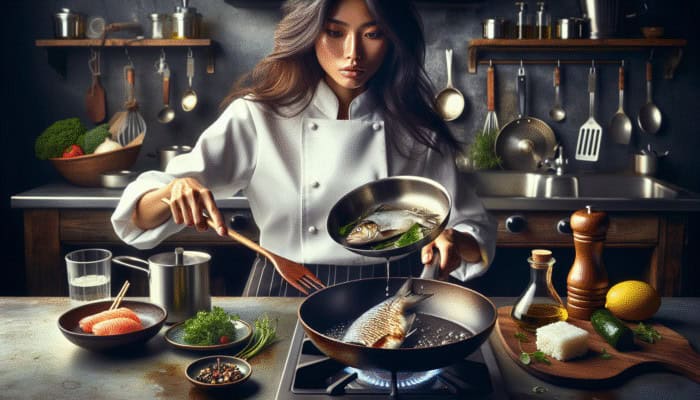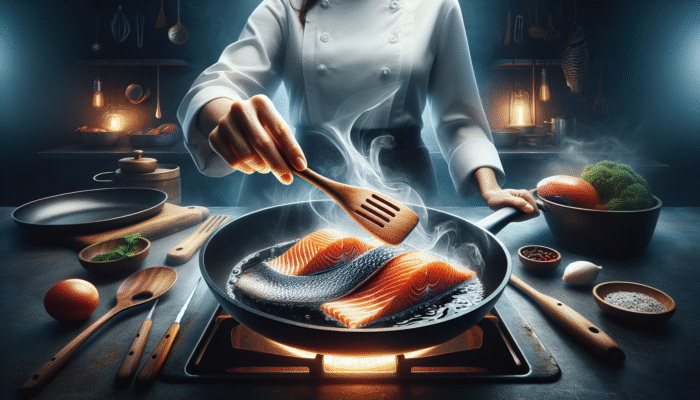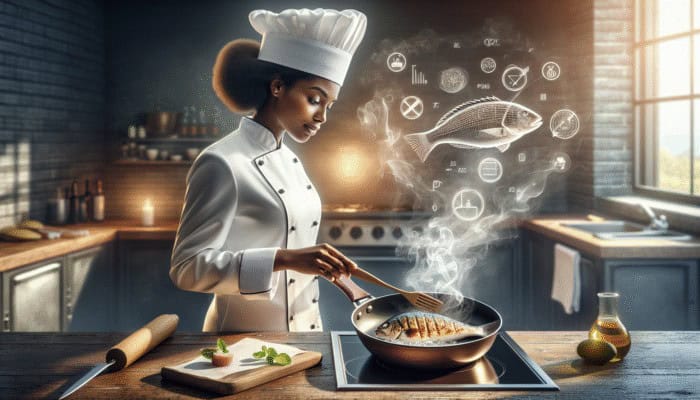Mastering the Art of Selecting the Perfect Pan for Searing Fish
Choosing the Right Material for Optimal Heat Conduction

Selecting the right pan is paramount when learning how to sear fish without sticking. The materials you choose can greatly influence your cooking results. Stainless steel and cast iron are the leading options, both renowned for their even heat distribution. Unlike non-stick pans, which may release harmful chemicals when overheated, these robust materials provide a resilient cooking surface that can endure high temperatures without warping. Stainless steel pans are particularly effective for developing a rich fond, the delectable browned bits that enhance sauces. Conversely, cast iron skillets excel in heat retention, delivering a superior sear. As you navigate through diverse culinary traditions, from Italy's coastal cuisines to Japan's meticulous sushi techniques, you'll discover that professional chefs frequently favour these materials for their durability and exceptional cooking prowess.
When selecting a pan, consider its weight. Heavier pans distribute heat more uniformly, which is crucial for achieving that perfect sear. A lightweight pan might struggle to hold its temperature, leading to uneven cooking and potential sticking issues. Seek a pan that complements your cooking style while feeling substantial in your hand. This connection between the chef and their tools can profoundly affect your cooking experience, making the process more enjoyable and effective.
Determining the Ideal Size and Shape of Your Pan for Fish
The size and shape of your pan are critical factors in successfully mastering how to sear fish without sticking. A pan that fits your fish snugly ensures maximum contact with the cooking surface, promoting even cooking throughout. This focus on fit is vital for delicate fish varieties such as sole or flounder, which can easily disintegrate without care. Conversely, larger pans can lead to uneven heating, increasing the risk of sticking as the fish may sit in cooler areas of the pan.
Additionally, the shape of the pan significantly influences heat circulation around the fish. A flat-bottomed frying pan is optimal because it allows the fish to lie flat, ensuring the maximum surface area is in contact with the heat source. As you explore culinary scenes worldwide, from the lively street food stalls in Thailand to elegant dining establishments in France, you'll notice that the shapes of cooking vessels are often tailored to local culinary practices, enriching the overall cooking experience.
Understanding the Crucial Role of Preheating Your Pan
Preheating your pan is a transformative step in mastering searing fish without sticking. A properly heated pan creates a naturally non-stick surface by ensuring that the proteins in the fish begin to cook immediately upon contact, forming a crust that helps the fish detach from the pan effortlessly. To achieve this, heat your pan over medium-high heat for a few minutes before introducing any oil or fish.
Many novice cooks overlook this essential step, resulting in frustrating sticking issues. The water drop test is a reliable method to check if your pan is ready: if a few drops of water dance and evaporate quickly on the surface, your pan is at the ideal temperature. This key technique is embraced in kitchens globally, from vibrant street vendors in Mexico to upscale restaurants in Italy, highlighting the universal significance of preheating for achieving culinary excellence.
Essential Steps in Preparing Fish for a Perfect Sear

Thoroughly Patting the Fish Dry for Optimal Results
To ensure success in learning to sear fish without sticking, begin with a thoroughly dry piece of fish. Excess moisture on the surface can lead to steaming rather than searing, which is not your desired outcome. Use paper towels to pat the fish dry, removing any moisture. This simple yet crucial step can significantly affect the overall result of your culinary creation.
In numerous cultures, from the picturesque coastal towns of Australia to the bustling seafood markets in Tokyo, the art of preparing fish is highly regarded. While the eagerness to cook may tempt you to place the fish directly in the pan, drying it will yield a beautifully browned exterior. Remember, the drier the fish, the better the sear. This approach enhances the texture and elevates the flavour, allowing the fish's natural taste to shine through in every bite.
Exploring Effective Seasoning Techniques for Fish
A well-seasoned fish is vital for elevating your searing skills, especially when mastering how to sear fish without sticking. Start with a light sprinkle of salt and pepper to enhance the fish’s inherent flavours. The key is to avoid excessive seasonings that can create a sticky residue, compromising the quality of the sear.
Delve into diverse seasoning techniques from around the globe. For instance, in Mediterranean cooking, aromatic herbs like thyme or rosemary are often paired with lemon zest, resulting in a fragrant and delicious crust. Alternatively, in Asian cooking, a soy sauce, ginger, and garlic marinade can infuse unique flavours without adding excess moisture. The goal is to complement the fish rather than overshadow it, allowing the cooking method's nuances to shine through.
Choosing Between Skin-On or Skinless Fish for Cooking

Deciding whether to cook fish with the skin on or off is a significant consideration regarding how to sear fish without sticking. Keeping the skin on can help protect the delicate flesh from overcooking while adding a delightful layer of texture and flavour. The skin acts as a natural barrier, promoting even heat distribution and locking in moisture within the fish.
Consider the regional preferences: in Scandinavian cooking, skin-on fish is commonplace, often grilled or pan-seared to crispy perfection. Conversely, many Asian dishes favour skinless fillets for a more refined presentation. Depending on your desired culinary outcome, both options have their advantages. If you leave the skin on, ensure it is meticulously dried and season only the flesh before introducing the fish to the preheated pan.
The Significance of Properly Preheating Your Pan
The importance of preheating your pan cannot be overstated when learning to sear fish without sticking. A hot pan is essential in achieving that coveted golden crust while preventing the fish from adhering to the surface. Heat your pan over medium-high heat for several minutes before adding oil or fish; this ensures the cooking surface is primed to create that perfect sear.
A common practice among chefs globally is to wait until the oil begins to shimmer before introducing the fish. This shimmering indicates that the pan has reached the ideal temperature for optimal cooking. Neglecting this critical step risks the fish sticking, potentially ruining your beautifully prepared meal. Whether following a recipe from a renowned chef in New York or a traditional dish from a fishing village in Greece, proper preheating is a universal technique that can dramatically enhance your cooking results.
Choosing the Right Fat for Cooking Fish
Identifying the Best Types of Cooking Oil
Selecting the right cooking oil is essential to sear fish without sticking. Opt for oils with high smoke points, such as avocado or grapeseed. These oils can endure higher temperatures without breaking down, which is vital for achieving that stunning sear.
Exploring oils from various culinary traditions can enhance your cooking experience. For example, extra virgin olive oil is a cherished choice in Mediterranean cuisine, celebrated for its flavour and health benefits. In Asian cuisines, sesame oil offers a distinct taste and aroma. However, it's essential to be mindful of the smoke point; while olive oil is fantastic for lower temperatures, refined varieties are better suited for high-heat cooking. Understanding the characteristics of different oils can elevate your searing techniques to new heights.
Determining the Right Amount of Fat for Cooking
The appropriate amount of fat is critical for successfully mastering how to sear fish without sticking. Using enough oil to coat the bottom of the pan is key; excessive fat can cause the fish to steam rather than sear, resulting in a dull crust. A light coating allows for even heat distribution while preventing sticking, so aim for moderation.
Consider the global perspectives on fat usage in cooking. In French cuisine, the classic technique often involves using clarified butter for its high smoke point and rich flavour. In contrast, Asian stir-fry methods typically use minimal oil, relying on the natural fats present in ingredients. The right approach is contingent upon the dish you prepare, but the emphasis on balance and moderation remains a common thread across culinary cultures.
Understanding the Timing of Adding Fat
When learning how to sear fish without sticking, the timing of adding oil to the pan is crucial. After preheating the pan, introduce the oil before placing the fish inside. This technique ensures the oil heats quickly, forming a barrier between the pan and the fish.
In culinary traditions worldwide, timing is a vital aspect of preparation. Many chefs develop an intuitive sense of when to add oil, honed through years of experience. The audible sizzling sound when the fish contacts the pan should be music to your ears, signalling the commencement of the cooking process. Please pay attention to the oil’s appearance; it should shimmer but not smoke, indicating it’s ready for the fish.
Efficient Practices for Reusing Cooking Fat
Reusing cooking fat is an efficient practice that can enhance your fish searing skills, particularly in understanding how to sear fish without sticking. If you've used oil for cooking fish, it can be reused several times, provided it is strained and stored properly to maintain quality. This practice is common in kitchens worldwide, from lively Asian street vendors to upscale European restaurants.
Straining the oil helps eliminate any lingering food particles that could affect the flavour of future dishes. Store it in a sealed container in a cool, dark place to prolong its life. However, exercise caution; once the oil emits a rancid smell or becomes excessively dark, it’s time to dispose of it. Embrace the global culinary wisdom of reusing quality fats to elevate your cooking while minimising waste.
Mastering Essential Searing Techniques for Fish
Perfecting the Initial Placement of Fish in the Pan
The initial placement of the fish in the pan is crucial when mastering how to sear fish without sticking. Gently lay the fish in the pan, ensuring it fully matches the surface. This technique promotes even cooking and reduces the risk of splattering hot oil, which can be hazardous.
In many culinary traditions, fish is often placed in the pan from the tail end, allowing for better control and smooth placement. This method is observed in home kitchens and professional settings across the globe. The aim is to avoid any unnecessary movement once the fish is in the pan, as this can compromise the quality of the sear.
Avoiding the Common Pitfall of Overcrowding the Pan
Overcrowding the pan is a frequent mistake when learning to sear fish without sticking. When too many pieces of fish are added simultaneously, the pan's temperature lowers, resulting in steaming rather than searing. For a successful cook, aim to work in batches if necessary, allowing each piece ample space to create a proper crust.
From bustling kitchens in New Orleans to tranquil home kitchens in rural Italy, chefs comprehend the importance of space in cooking. Working in batches ensures a perfect sear and allows you to focus on each piece, ensuring that no part is overcooked or undercooked. This technique underscores the significance of patience and attention to detail in the culinary arts.
Timing for Flipping the Fish to Achieve the Perfect Sear
Flipping the fish at the right moment is essential for achieving that ideal sear when learning to sear fish without sticking. Please wait until the fish naturally releases from the pan; this indicates that it is ready to be flipped. Attempting to flip too early may result in the fish sticking, ruining the presentation and texture.
Many seasoned chefs develop a keen instinct for when to flip based on the sound and appearance of the fish. Observing the edges turning opaque serves as a helpful visual cue. Timing may vary across various culinary traditions, but patience remains a universally valued trait. Allowing the fish to develop a crust before flipping enhances flavour and texture, ensuring a delightful dining experience.
Mastering Temperature Control for Perfect Searing
Understanding the Importance of Heat Levels
Maintaining the appropriate heat level is vital for searing fish without sticking. Medium-high heat is ideal for achieving a good sear without burning the fish. Excessively high temperatures can lead to a charred exterior while leaving the inside undercooked, while heat that is too low can cause sticking as the fish releases moisture.
Chefs worldwide are acutely aware of the significance of heat control. In Asian stir-frying techniques, precise temperature management is crucial for achieving the desired texture and flavour balance. Understanding your stovetop's capabilities and the specific requirements of the fish you’re cooking will empower you to achieve professional results right in your kitchen.
Utilising Thermometers for Accurate Temperature Monitoring
A thermometer can elevate your cooking to the next level, especially when learning to sear fish without sticking. Monitoring the pan’s temperature helps ensure consistent results. If you aim for perfect doneness, investing in a good instant-read thermometer is worthwhile.
This tool is widely used in kitchens worldwide, from Michelin-starred establishments to home cooks. Knowing the optimal cooking temperature for different fish types will allow you to adjust your technique accordingly. For example, thicker cuts like salmon may require higher heat for longer, while delicate fillets like cod benefit from a gentler approach to cooking.
Adjusting Heat for Optimal Cooking Results
Being prepared to adjust the heat is key to successfully searing fish. If you observe sticking or burning, don’t hesitate to lower the heat slightly. This adaptability is essential for consistently achieving excellent results when learning to spear fish without sticking.
In various culinary cultures, from the spicy kitchens of Southeast Asia to the diverse flavours of South America, chefs adapt their techniques based on the unique characteristics of their ingredients. Developing this skill will enhance your overall cooking experience, enabling you to respond dynamically to the ever-changing conditions in the kitchen.
Perfecting Timing and Patience in Fish Searing
Determining the Right Searing Duration
Timing is everything when learning how to sear fish without sticking. Allow the fish to sear for the right amount of time, typically around 3-4 minutes per side, depending on the thickness of the fillet. This duration enables the exterior to develop a stunning golden crust while keeping the interior moist and flaky.
Culinary experts from various cultures emphasise the significance of patience in cooking. Eagerly flipping or moving the fish prematurely can compromise the sear. Understanding the optimal timing enhances your dish and builds confidence in your cooking abilities, empowering you to experiment with diverse techniques and flavours.
Resisting the Urge to Move the Fish Prematurely
The temptation to move the fish too soon can undermine your efforts when learning to sear fish without sticking. Please resist the urge to check or flip the fish until it has developed a beautiful crust. This patience is critical for achieving that perfect sear.
In kitchens worldwide, chefs adhere to this principle, waiting for the natural cues that indicate readiness. Whether it’s the sizzling sound or the visual cues of colour change, every culinary culture has methods for ensuring a successful cook. Trusting the process is essential; your patience will reward you with a beautifully seared piece of fish that will impress you.
Mastering the Art of Checking Fish Doneness
Knowing when your fish is perfectly cooked is an art form that can significantly enhance your skills to sear fish without sticking. Using a fork or spatula, gently check if the fish is ready by flaking a small piece at the thickest part. If it flakes easily, it is likely done and ready to serve.
This technique is universally employed in kitchens around the world. Many chefs advocate a gentle approach, allowing you to gauge doneness without disrupting the sear. Familiarising yourself with the specific cooking times for various fish species will also enrich your understanding of fish preparation, leading to more confident and successful cooking experiences.
Essential Practices for Pan Maintenance
Ensuring a Clean Pan Before Use
Ensuring your pan is clean and residue-free is essential when learning to sear fish without sticking. Any remnants from previous cooking can lead to unwanted flavours and potential sticking issues. Before using your pan, wash it thoroughly with warm, soapy water, and dry it completely to prevent moisture from affecting your cooking process.
Many professional chefs worldwide understand the significance of maintaining their tools. A well-cared-for pan can last years and improve, developing a natural patina that enhances its non-stick capabilities. Establishing a regular cleaning routine ensures that your pans are always primed for your next culinary adventure.
The Art of Seasoning Your Pan
Seasoning is a crucial aspect of maintenance for cast iron and carbon steel pans. This process involves applying a thin layer of oil to the pan and heating it to create a natural non-stick surface. Regular seasoning helps prevent rust and maintains the pan’s ability to sear fish effectively.
This practice is especially prevalent in kitchens worldwide, where quality cookware is highly valued. Learning how to care for your pans will extend their lifespan and enhance your cooking results, making it a vital skill for any aspiring chef looking to master their craft.
Storing and Caring for Your Pans Properly
Properly storing your pans is as important as cleaning and seasoning them when mastering searing fish without sticking. Ensure your pans are kept dry to prevent moisture build-up, which can lead to rust, especially with cast iron. For non-stick pans, consider using protective liners to avoid scratching the surface.
In culinary traditions worldwide, the care of cooking equipment is taken seriously. Many chefs invest time in selecting the right storage solutions for their tools, ensuring they remain in optimal condition. By diligently caring for your pans, you set yourself up for success in the kitchen, enabling you to create culinary masterpieces with ease.
Frequently Asked Questions About Searing Fish
Which type of pan is best for searing fish?
A heavy-bottomed stainless steel or cast iron pan is ideal. These materials provide even heat distribution and are less prone to sticking, making them perfect for achieving a great sear.
How can I tell when the fish is ready to flip?
Wait until the fish releases easily from the pan and the edges appear opaque. This ensures you achieve a perfect sear without damaging the fish.
Is a non-stick pan suitable for searing fish?
While non-stick pans can be convenient, they may not provide the same depth of flavour as stainless steel or cast iron, which create a rich fond that enhances your dishes.
What steps can I take to prevent fish from sticking to the pan?
Ensure your pan is preheated correctly, fish thoroughly, and use the right amount of oil for searing. These steps are crucial for achieving a successful cook.
Can I reuse oil after cooking fish?
Yes, you can reuse oil a few times, but strain it and store it properly to prevent off-flavours from affecting your next cooking venture.
Is it better to cook fish skin-side down?
Cooking fish skin-side down helps protect the flesh and allows for a crispy texture while searing, enhancing the overall quality of your dish.
What is the ideal temperature for searing fish?
Aim for medium-high heat, around 375°F (190°C), to achieve a good sear without risking burning the fish.
How long should I sear fish on each side?
Generally, fish should be seared for 3-4 minutes per side, depending on the thickness of the fillet, to achieve optimal results and flavour.
What types of oil are best for searing fish?
Oils with high smoke points, like avocado oil or grapeseed oil, are the best choices for searing fish without burning.
How can I tell when the fish is cooked through?
Use a fork to flake the thickest part of the fish gently; if it flakes easily and appears opaque, it’s cooked to perfection.



This is such an insightful exploration of cookware materials! I’ve always been a fan of using cast iron for searing fish—it really does create a beautiful crust while holding the heat remarkably well. I remember my first attempt at cooking salmon in a cast iron pan; I was nervous about sticking, but with the right preheating and a bit of oil, the outcome was deliciously rewarding.